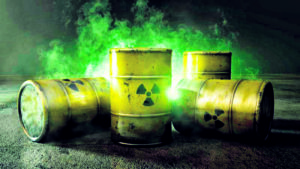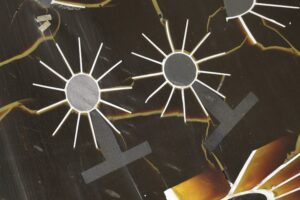Fact from Fiction – What is nuclear energy and why must we deal with the waste?
When you hear the term ‘radioactive waste’, what images come to mind?

Nuclear waste is not stored like this
This waste actually comes in many different shapes and sizes. Despite what certain TV programmes would have you believe, one thing it definitely does not look like is barrels of green slime. Liquids can spill and leak, so to protect people and the environment, radioactive waste is never disposed of in liquid form.
People tend to think of stereotypes such as glowing neon ooze kept in large yellow oil drums. Many fear that nuclear waste can be turned into bombs, or will leak radiation into our towns. None of this is true!

Nuclear waste is stored as a solid
Nuclear waste is stored as a solid
Higher activity waste looks like this image on the left, when made solid. It is then stored in secure steel canisters.
Radiation is all around us and comes from many sources. It comes from rocks in the ground to medical equipment, and low amounts are handled safely. Questions have been raised about whether we need nuclear energy. However around a fifth of the overall electricity supply to the UK’s homes and businesses already comes from nuclear energy.
Nuclear technology has been part of our daily lives for more than 60 years and plays a critical role in a number of industries, including in our NHS and defence sector. But waste from this use has accumulated over the decades – with more to come from the planned decommissioning of current power plants.
Most of this waste, around 90 per cent is classified as low-level in terms of radioactivity and is already being disposed of safely. It is the higher activity waste that needs to be handled with particular care.
 Waste disposal is a long term solution
Waste disposal is a long term solution
Waste is currently packaged and held in secure, aboveground stores at more than 20 sites across the UK, including Sellafield. While this is safe, it is not a long-term solution. The sites will require monitoring, maintenance and refurbishment for hundreds of thousands of years, and the buildings will have to be replaced every hundred years or so.
A Geological Disposal Facility (GDF) will be hundreds of metres underground, with multiple barriers of stable rock combined with expert engineering infrastructure keeping people and the environment safe. The higher activity waste to be disposed of underground includes that which comes from the reprocessing of spent fuel used in nuclear reactors. This is typically in liquid form, but is made solid and stable using a process called vitrification.
This diagram shows an example of a high level waste canister – where the vitrified solid waste is securely contained inside the engineered container.
To make intermediate level waste safe to store, we place it into stainless steel drums or boxes, usually after breaking it up to make it smaller and easier to package. Most of these are 500-litre drums, like a cross between an oil drum and a milk churn, but made of stainless steel. These containers are then filled with cement. The amount of waste to be packaged for a GDF depends on how the UK uses radioactive materials in future.
Nuclear Waste Services, which is assessing potential GDF sites, estimates that around 650,000 cubic metres of higher activity waste and nuclear material will be sent to a GDF, once it is built and in operation.

